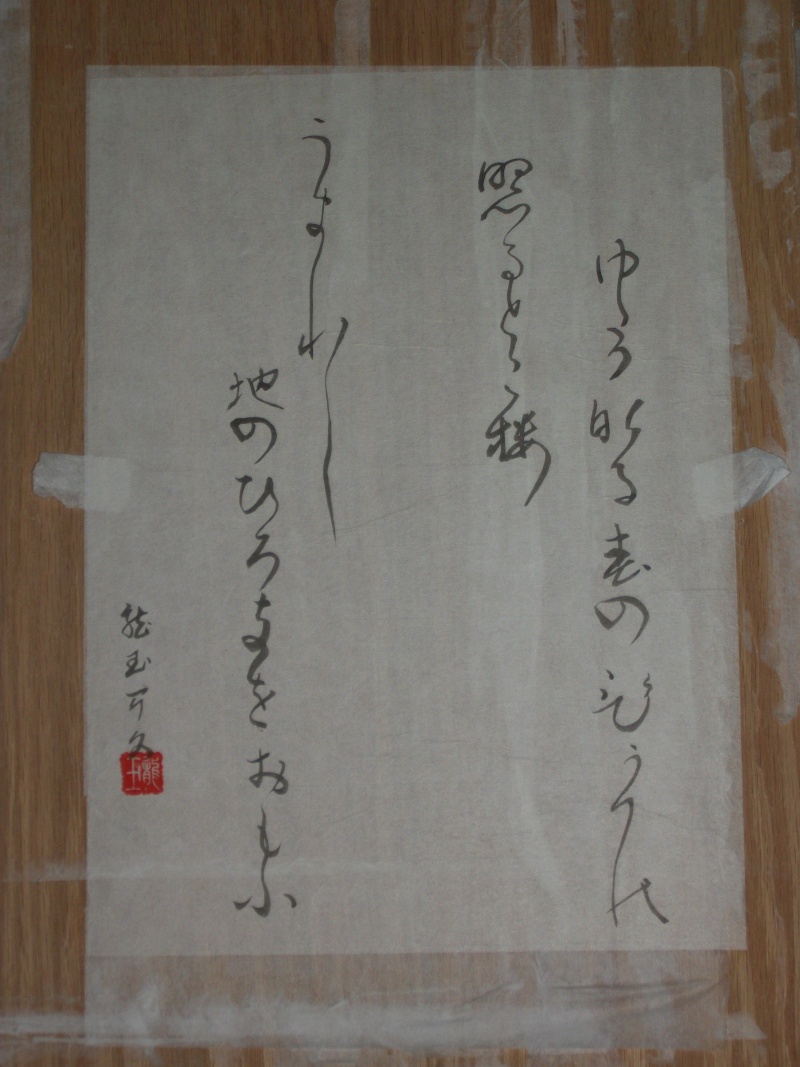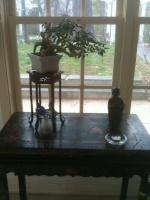Distinguishing Japanese Calligraphy Styles
2 posters
Page 1 of 1
 Distinguishing Japanese Calligraphy Styles
Distinguishing Japanese Calligraphy Styles
I am posting this so that interested parties can learn about some of the different types of Calligraphy styles. In Japanese there are many different writing styles that have developed.

Calligraphy Scrolls utilized for formal Bonsai display, which often use seasonal phrases and poetry, typically incorporate the Sousho and Kana style. But there are many types of writing for many different purposes. But each has a beauty and a place or need.
Sousho writing is typically illegible by Japanese, and is only known by the artist. There are several ways to write the character, but it is distinguished by abbreviating the writing into one or two brushstrokes. It is artistic and flowing. This first picture is a sample of a scroll that was written in the Sousho style. The phrase reads, “I Have Burning Questions” or我心要問在 in Japanese. (For you UK'ers this is a quote from Sir David Attenborough...pray I spelled his name correctly)

Kana Calligraphy is a purely Japanese style of writing. The lines are not uniform, because they break the lines and lengthen or shorten it to enhance the theme of the writing or create deeper meaning to the verse. It is typically written with a Hosofude or thin brush. There is typically a mix of Chinese characters and Syllabic characters called hiragana. The hiragana is usually legible but the Kanji is sometimes abbreviated and difficult to read.

Gyousho, is the semi-cursive style of writing. This is usually legible and is recognizable by the connection of strokes. This long narrow scroll is a sample of Gyousho writing. The scroll reads 兵法は平方なり Heihou wa Heihou nari The Art of War is the Art of Peace. If you look closely this is a play on the word Heihou, which has the same pronunciation but different meaning by changing the first character in the scroll.

In some cases the shoka or calligrapher may mix and have both legible Gyousho and Sousho writing in the same piece. This is the case with the scroll pictured here. My wife said this was listed in her Calligraphy Examination as Gyousou. The first and second characters on the top left hand column are fairly legible. The first and third characters in the left hand column are also in the Gyousho form, meaning they are legible. The remaining characters are very difficult to read and are in the Sousho style. The meaning of this scroll is below.
照渓苦芳樹紅雲合迎客幽禽翠雨軽し
読み 渓を照らす芳樹紅雲合し 客を迎える幽禽翠雨軽し (けいをてらすほうじゅこううんがっし きゃくをむかえるゆうきんすいうかるし
In the valley, the fragrance of the orchards wafts in the air, and crimson clouds gather. During the light rainfall, the beautiful birds come resting on the new green branches, which have awaited the return of their nimble visitors.

The block print style of writing mimics the figures typed in a computer. It is the most recognizable and is required for those who wish to start the practice of calligraphy. Each stroke is followed exactly and there is little or no connection between the consecutive strokes on the work. This is recognizable in the kakejiku to the left.

Calligraphy Scrolls utilized for formal Bonsai display, which often use seasonal phrases and poetry, typically incorporate the Sousho and Kana style. But there are many types of writing for many different purposes. But each has a beauty and a place or need.
Sousho writing is typically illegible by Japanese, and is only known by the artist. There are several ways to write the character, but it is distinguished by abbreviating the writing into one or two brushstrokes. It is artistic and flowing. This first picture is a sample of a scroll that was written in the Sousho style. The phrase reads, “I Have Burning Questions” or我心要問在 in Japanese. (For you UK'ers this is a quote from Sir David Attenborough...pray I spelled his name correctly)

Kana Calligraphy is a purely Japanese style of writing. The lines are not uniform, because they break the lines and lengthen or shorten it to enhance the theme of the writing or create deeper meaning to the verse. It is typically written with a Hosofude or thin brush. There is typically a mix of Chinese characters and Syllabic characters called hiragana. The hiragana is usually legible but the Kanji is sometimes abbreviated and difficult to read.

Gyousho, is the semi-cursive style of writing. This is usually legible and is recognizable by the connection of strokes. This long narrow scroll is a sample of Gyousho writing. The scroll reads 兵法は平方なり Heihou wa Heihou nari The Art of War is the Art of Peace. If you look closely this is a play on the word Heihou, which has the same pronunciation but different meaning by changing the first character in the scroll.

In some cases the shoka or calligrapher may mix and have both legible Gyousho and Sousho writing in the same piece. This is the case with the scroll pictured here. My wife said this was listed in her Calligraphy Examination as Gyousou. The first and second characters on the top left hand column are fairly legible. The first and third characters in the left hand column are also in the Gyousho form, meaning they are legible. The remaining characters are very difficult to read and are in the Sousho style. The meaning of this scroll is below.
照渓苦芳樹紅雲合迎客幽禽翠雨軽し
読み 渓を照らす芳樹紅雲合し 客を迎える幽禽翠雨軽し (けいをてらすほうじゅこううんがっし きゃくをむかえるゆうきんすいうかるし
In the valley, the fragrance of the orchards wafts in the air, and crimson clouds gather. During the light rainfall, the beautiful birds come resting on the new green branches, which have awaited the return of their nimble visitors.

The block print style of writing mimics the figures typed in a computer. It is the most recognizable and is required for those who wish to start the practice of calligraphy. Each stroke is followed exactly and there is little or no connection between the consecutive strokes on the work. This is recognizable in the kakejiku to the left.

Kakejiku- Member
 Re: Distinguishing Japanese Calligraphy Styles
Re: Distinguishing Japanese Calligraphy Styles
This is very interesting. Your explanation of different styles got my attention because I have a(n) Usubata that my parents brought back from Japan, during the Korean conflict. My parents were told that it was very old because none of the interpetors could read the calligraphy. (many poeple who acquired artifacts,etc in Japan think they have very valuable antiques... we were raised with this notion, only to find out that some items really were not as old as we thought...) I wonder if the calligraphy is "Sousho"?
Thank you for sharing your knowledge and pictures.
Salut,
Todd
Thank you for sharing your knowledge and pictures.
Salut,
Todd

Todd Ellis- Member
 Similar topics
Similar topics» Calligraphy on pots
» Bonsai styles of the world
» The Waterfall Scroll that was sold
» Bonsai Styles
» Ideas for styles!?
» Bonsai styles of the world
» The Waterfall Scroll that was sold
» Bonsai Styles
» Ideas for styles!?
Page 1 of 1
Permissions in this forum:
You cannot reply to topics in this forum|
|
|







